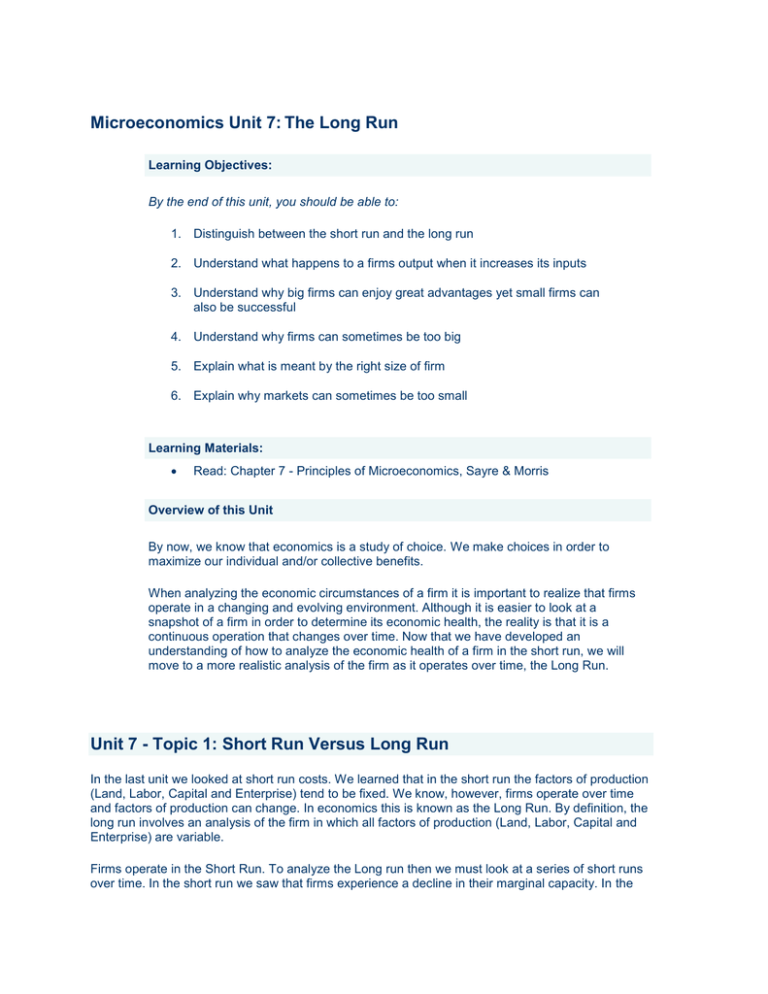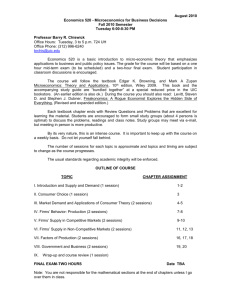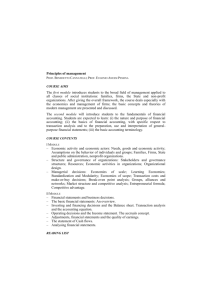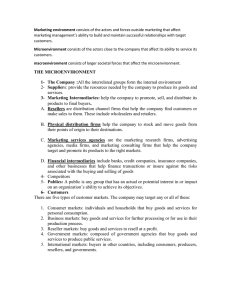EC1100 Microeconomics - PT (CL) - Unit 7. Long Run Production
advertisement

Microeconomics Unit 7: The Long Run Learning Objectives: By the end of this unit, you should be able to: 1. Distinguish between the short run and the long run 2. Understand what happens to a firms output when it increases its inputs 3. Understand why big firms can enjoy great advantages yet small firms can also be successful 4. Understand why firms can sometimes be too big 5. Explain what is meant by the right size of firm 6. Explain why markets can sometimes be too small Learning Materials: Read: Chapter 7 - Principles of Microeconomics, Sayre & Morris Overview of this Unit By now, we know that economics is a study of choice. We make choices in order to maximize our individual and/or collective benefits. When analyzing the economic circumstances of a firm it is important to realize that firms operate in a changing and evolving environment. Although it is easier to look at a snapshot of a firm in order to determine its economic health, the reality is that it is a continuous operation that changes over time. Now that we have developed an understanding of how to analyze the economic health of a firm in the short run, we will move to a more realistic analysis of the firm as it operates over time, the Long Run. EC1100 Microeconomics - PT (CL) - Unit 7. Long Run Production Costs - Short Run Versus Long Run Unit 7 - Topic 1: Short Run Versus Long Run In the last unit we looked at short run costs. We learned that in the short run the factors of production (Land, Labor, Capital and Enterprise) tend to be fixed. We know, however, firms operate over time and factors of production can change. In economics this is known as the Long Run. By definition, the long run involves an analysis of the firm in which all factors of production (Land, Labor, Capital and Enterprise) are variable. Firms operate in the Short Run. To analyze the Long run then we must look at a series of short runs over time. In the short run we saw that firms experience a decline in their marginal capacity. In the long run however this does not have to be the case because firms can adapt and change their size to accommodate change. To go back to our analogy of adding cooks in the kitchen, in the short run too many cooks in the kitchen will eventually lead to an overall reduction in the contribution of each additional cook. In the long run we could simply increase the size of the kitchen to accommodate the extra help and thereby allow us to continue to increase output - more cooks in a bigger kitchen preparing more food! EC1100 Microeconomics - PT (CL) - Unit 7. Long Run Production Costs - Economies of Scale Unit 7 - Topic 2: Economies of Scale As a firm gets bigger it can benefit from various cost reductions that occur due to size. The situation in which a firms growing output increases by a greater percentage than do its inputs is known as increasing returns to scale. Why is this so? Two major factors contribute to this: Technical Economies Of Scale, also referred to as increasing returns to scale and Pecuniary (money related) economies of scale Technical Economies of Scale Technical economies include cost advantages achieved through specialization and the division of labour. This is exemplified through assembly line operations. A product, such as a car, rolls down an assembly line allowing a specific person on the line to complete a specific task such as mounting the engine, installing a tire or installing a windshield. Seeing the task is specific and repeated the worker can become very proficient at performing it reducing time and cost. Another technical economy involves the use of specialized tools to do a certain task. Large-scale mass production operations allow tools to be specialized so that they can perform a specific task very quickly and very well. Finally, technical economies also include the specialization of managers who in large-scale operations can each focus on a narrow aspect of managerial responsibility. Pecuniary (money related) Economies of Scale Larger firms also benefit from access to lower cost money. Borrowing costs are often lower for largescale established firms. With larger financial resources and higher volumes, larger firms can also buy or sell larger quantities of products and buy more and therefore lower relative cost advertising space. Finally, large firms do such high volumes that they produce sufficient by-products (left-overs, excess, waste material) that in-turn they can sell to other firms. EC1100 Microeconomics - PT (CL) - Unit 7. Long Run Production Costs - Advantages of Bigness Unit 7 - Topic 3 - Advantages of Bigness As a firm gets bigger it can benefit from various cost reductions that occur due to size. The situation in which a firm's growing output increases by a greater percentage than do its inputs is known as increasing returns to scale. Why is this so? Two major factors contribute to this: Technical Economies Of Scale, also referred to as increasing returns to scale and Pecuniary (money related) economies of scale. Technical Economies of Scale Technical economies include cost advantages achieved through specialization and the division of labour. This is exemplified through assembly line operations. A product, such as a car, rolls down an assembly line allowing a specific person on the line to complete a specific task such as mounting the engine, installing a tire or installing a windshield. Seeing the task is specific and repeated, the worker can become very proficient at performing it reducing time and cost. Another technical economy involves the use of specialized tools to do a certain task. Large-scale mass production operations allow tools to be specialized so that they can perform a specific task very quickly and very well. Finally, technical economies also include the specialization of managers who in large-scale operations can each focus on a narrow aspect of managerial responsibility. Pecuniary (money related) Economies of Scale Larger firms also benefit from access to lower cost money. Borrowing costs are often lower for largescale established firms. With larger financial resources and higher volumes, larger firms can also buy or sell larger quantities of products and buy more and therefore lower relative cost advertising space. Finally, large firms do such high volumes that they produce sufficient by-products (left-overs, excess, waste material) that in-turn they can sell to other firms. EC1100 Microeconomics - PT (CL) - Unit 7. Long Run Production Costs - Disadvantages of Bigness Unit 7 - Topic 4: Disadvantages of Bigness Firms can grow too big for their own good especially in times of economic slowdown. Airlines have provided a good example of how bigness can be a double-edged sword. Large airlines such as Air Canada have lots of aircraft allowing them to provide good market coverage and lots of flights. After the terrorist attacks of September 2001 many people stopped flying leaving Air Canada and many other large airlines flying large aircrafts with empty seats. As the market shrunk, Air Canada could not shrink quickly enough with it forcing them to seek bankruptcy protection. Improved Technology is often seen as a way to preserve the benefits of economies of scale in the face of rising costs or a declining market. Since 2001 Air Canada has downsized its fleet and bought new more fuel-efficient aircrafts. These new airplanes, such as the new Boeing 777 and 787, allow Air Canada to remain relatively large while at the same time reducing its operating costs. EC1100 Microeconomics - PT (CL) - Unit 7. Long Run Production Costs Firm Determine the Right Size of a Unit 7 - Topic 5: Determine the right size of a firm Firms need to be large enough to obtain the advantages offered by increasing economies of scale, while are the same time not too big to suffer the problems that arise from being too big to quickly adapt to market changes. Finding the right size for a firm is critical to its long term survival and success. Using the tools described in the proceeding sections managers can better determine the right size for their firm in the long run. EC1100 Microeconomics - PT (CL) - Unit 7. Long Run Production Costs Business The Effect of Market Size on Unit 7 - Topic 6: The Effect of Market Size on Business Success Imagine starting a hair cutting shop in a town of 10 people. Not only does size matter for a business size matters for the market. In small markets it is very difficult for firms that serve just that market to reduce their costs sufficiently to survive. Opening a hair cutting shop in a town of 10 may not be a good idea, but if you can draw customers from other nearby towns it may not be such a bad idea! EC1100 Microeconomics - PT (CL) - Unit 7. Long Run Production Costs - Summary Unit 7 - Summary In this unit you learned that in economics, the Long Run is defined as the period of time over which all of the factors of production can change. (Land, Labour, Capital and Enterprise can all be adjusted). In reality, firms operate in the short run at any given point in time so to study the long run we must look at a series of short runs over time. As firms grow they can achieve cost reductions per unit of production through a combination of improved technical efficiencies and improved pecuniary (financial related) efficiencies. Once a certain size is reached, however, costs will begin to rise again owing to inefficiencies that result from bigness. These inefficiencies are known as diseconomies of scale. The key managerial decision than needs to be made using the long run economic analysis tools presented in this unit is: What is the right size for a business in the market in which it operates? The analytical tools presented help you make this determination. EC1100 Microeconomics - PT (CL) - Unit 7. Long Run Production Costs - Suggested Problems Unit 7 - Suggested Problems In order to reinforce what you have learned in this unit I suggest you review the following end-of chapter problems. Once you have attempted this, review Student Answer Key. Answered Problems: 36A & 47A EC1100 Microeconomics - PT (CL) - Unit 7. Long Run Production Costs - Additional Material Unit 7 - Additional Material Select a link below to view additional course materials: Quizzes Multiple Choice Quiz Internet Application Quiz More Resources Key Terms Student Answer Key







